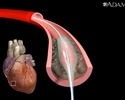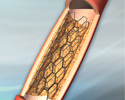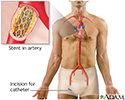Angioplasty and stent - heart - discharge
Drug-eluting stents - discharge; PCI - discharge; Percutaneous coronary intervention - discharge; Balloon angioplasty - discharge; Coronary angioplasty - discharge; Coronary artery angioplasty - discharge; Cardiac angioplasty - discharge; PTCA - discharge; Percutaneous transluminal coronary angioplasty - discharge; Heart artery dilatation - discharge; Angina angioplasty - discharge; Heart attack angioplasty - discharge; CAD angioplasty - dischargeAngioplasty is a procedure to open narrowed or blocked blood vessels that supply blood to the heart. These blood vessels are called the coronary arteries. A coronary artery stent is a small, metal mesh tube that expands inside a coronary artery.
When You're in the Hospital
You had angioplasty when you were in the hospital. You may have also had a stent placed. Both of these were done to open narrowed or blocked coronary arteries, the blood vessels that supply blood to your heart. You may have had a heart attack or angina (chest pain) before the procedure.
Heart attack
Most heart attacks are caused by a blood clot that blocks one of the coronary arteries. The coronary arteries bring blood and oxygen to the heart. ...

Angina
Angina is a type of chest discomfort or pain due to poor blood flow through the blood vessels (coronary vessels) of the heart muscle (myocardium). T...
Read Article Now Book Mark ArticleWhat to Expect at Home
You may have pain in your groin area, arm, or wrist. This is from the catheter (flexible tube) that was inserted to do the procedure. You may also have some bruising around and below the incision.
The chest pain and shortness of breath you likely had before the procedure should be much better now.
Self-care
In general, people who have angioplasty can walk around within 6 hours after the procedure. You may be able to be up and walking earlier if the procedure was performed through the wrist. Complete recovery takes a week or less. Keep the area where the catheter was inserted dry for 24 to 48 hours.
If the provider put the catheter in through your groin:
- Walking short distances on a flat surface is OK. Limit going up and down stairs to around 2 times a day for the first 2 to 3 days.
- Don't do yard work, drive, squat, carry heavy objects, or play sports for at least 2 days, or until your health care provider tells you it is safe.
If the provider put the catheter in your arm or wrist:
- Don't lift anything heavier than 10 pounds (4.5 kilograms) (a little more than a gallon of milk) with the arm that had the catheter.
- Don't do any heavy pushing, pulling or twisting with that arm.
For a catheter in your groin, arm, or wrist:
- Avoid sexual activity for 2 to 5 days. Ask your provider when it will be OK to start again.
- Don't take a bath or swim for the first week. You may take showers, but make sure the area where the catheter was inserted does not get wet for the first 24 to 48 hours.
- You should be able to return to work in 2 to 3 days if you do not do heavy work.
You will need to care for your incision.
- Your provider will tell you how often to change your dressing.
- If your incision bleeds or swells up, lie down and put pressure on it for 30 minutes.
Angioplasty does not cure the cause of the blockage in your arteries. Your arteries may become narrow again. Eat a heart-healthy diet, exercise, stop smoking (if you smoke), and reduce stress to help lower your chances of having a blocked artery again. Your provider may give you medicine to help lower your cholesterol.
Most people take aspirin together with another antiplatelet medicine such as clopidogrel (Plavix), prasugrel (Efient), or ticagrelor (Brilinta) after this procedure. These medicines are blood thinners. They keep your blood from forming clots in your arteries and stent. A blood clot can lead to a heart attack. Take the medicines exactly as your provider tells you. Do not stop taking them without talking with your provider first.
Aspirin
Current guidelines recommend that people with coronary artery disease (CAD) receive antiplatelet therapy with either aspirin or clopidogrel. Aspirin ...

Clopidogrel
Platelets are small cells in your blood that your body uses to form clots and stop bleeding. If you have too many platelets or your platelets stick ...

You should know how to take care of your angina if it returns.
Take care of your angina
Angina is a type of chest discomfort due to poor blood flow through the blood vessels of the heart muscle. This article discusses how to care for yo...
Read Article Now Book Mark ArticleMake sure you have a follow-up appointment scheduled with your heart care provider (cardiologist).
Your provider may refer you to a cardiac rehabilitation program. This will help you learn how to slowly increase your exercise. You will also learn how to take care of your angina and care for yourself after a heart attack.
Slowly increase your exercise
Angina is a type of chest discomfort due to poor blood flow through the blood vessels of the heart muscle. This article discusses how to care for yo...

Take care of your angina
Angina is a type of chest discomfort due to poor blood flow through the blood vessels of the heart muscle. This article discusses how to care for yo...

Care for yourself after a heart attack
A heart attack occurs when blood flow to a part of your heart is blocked long enough that part of the heart muscle is damaged or dies. This article ...

When to Call the Doctor
Contact your provider if:
- There is bleeding at the catheter insertion site that does not stop when you apply pressure.
- There is swelling at the catheter site.
- Your leg or arm below where the catheter was inserted changes color, becomes cool to touch, or is numb.
- The small incision for your catheter becomes red or painful, or yellow or green discharge is draining from it.
- You have chest pain or shortness of breath that does not go away with rest.
- Your pulse feels irregular -- very slow (fewer than 60 beats), or very fast (over 100 to 120 beats) a minute.
- You have dizziness, fainting, or you are very tired.
- You are coughing up blood or yellow or green mucus.
- You have problems taking any of your heart medicines.
- You have chills or a fever over 101°F (38.3°C).
References
Amsterdam EA, Wenger NK, Brindis RG, et al. 2014 AHA/ACC guideline for the management of patients with non-ST-elevation acute coronary syndromes: a report of the American College of Cardiology/American Heart Association Task Force on practice guidelines. J Am Coll Cardiol. 2014;64(24):e139-e228. PMID: 25260718 pubmed.ncbi.nlm.nih.gov/25260718/.
Dangas GD, Mehran R. Coronary angiography and intravascular imaging. In: Libby P, Bonow RO, Mann DL, Tomaselli GF, Bhatt DL, Solomon SD, eds. Braunwald's Heart Disease: A Textbook of Cardiovascular Medicine. 12th ed. Philadelphia, PA: Elsevier; 2022:chap 21.
Fihn SD, Blankenship JC, Alexander KP, et al. 2014 ACC/AHA/AATS/PCNA/SCAI/STS focused update of the guideline for the diagnosis and management of patients with stable ischemic heart disease: a report of the American College of Cardiology/American Heart Association Task Force on Practice Guidelines, and the American Association for Thoracic Surgery, Preventive Cardiovascular Nurses Association, Society for Cardiovascular Angiography and Interventions, and Society of Thoracic Surgeons. J Thorac Cardiovasc Surg. 2015;149(3):e5-e23. PMID: 25827388 pubmed.ncbi.nlm.nih.gov/25827388/.
Kumbhani DJ, Bhatt DL. Percutaneous coronary intervention. In: Libby P, Bonow RO, Mann DL, Tomaselli GF, Bhatt DL, Solomon SD, eds. Braunwald's Heart Disease: A Textbook of Cardiovascular Medicine. 12th ed. Philadelphia, PA: Elsevier; 2022:chap 41.
O'Gara PT, Kushner FG, Ascheim DD, et al. 2013 ACCF/AHA guideline for the management of ST-elevation myocardial infarction: executive summary: a report of the American College of Cardiology Foundation/American Heart Association Task Force on practice guidelines. Circulation. 2013;127(4):529-555. PMID: 23247303 pubmed.ncbi.nlm.nih.gov/23247303/.
-
Balloon angioplasty - short segment
Animation
-
Stent
Animation
-
Coronary artery stent - illustration
A coronary artery stent is a small, metal mesh tube that is placed inside a coronary artery to help keep the artery open. To place the stent, a small sheath, plastic tube, is placed in the groin or wrist artery. A catheter is guided through the artery into the part of the coronary artery that is blocked. The stent is inserted along with a balloon catheter and expands when the balloon is inflated. The stent is then left there to help keep the artery open.
Coronary artery stent
illustration
-
Coronary artery stent - illustration
A coronary artery stent is a small, metal mesh tube that is placed inside a coronary artery to help keep the artery open. To place the stent, a small sheath, plastic tube, is placed in the groin or wrist artery. A catheter is guided through the artery into the part of the coronary artery that is blocked. The stent is inserted along with a balloon catheter and expands when the balloon is inflated. The stent is then left there to help keep the artery open.
Coronary artery stent
illustration
Review Date: 8/16/2022
Reviewed By: Michael A. Chen, MD, PhD, Associate Professor of Medicine, Division of Cardiology, Harborview Medical Center, University of Washington Medical School, Seattle, WA. Also reviewed by David C. Dugdale, MD, Medical Director, Brenda Conaway, Editorial Director, and the A.D.A.M. Editorial team.





